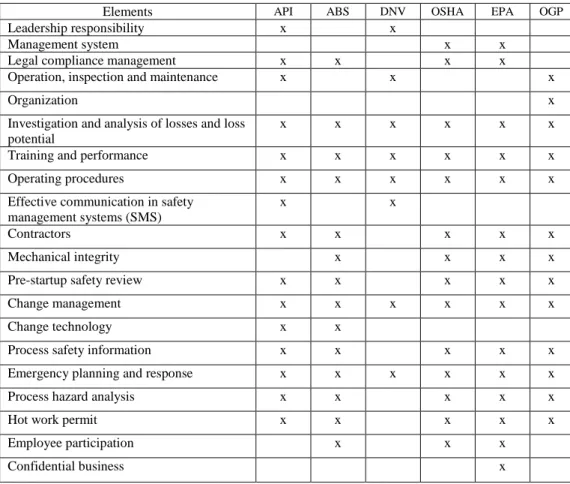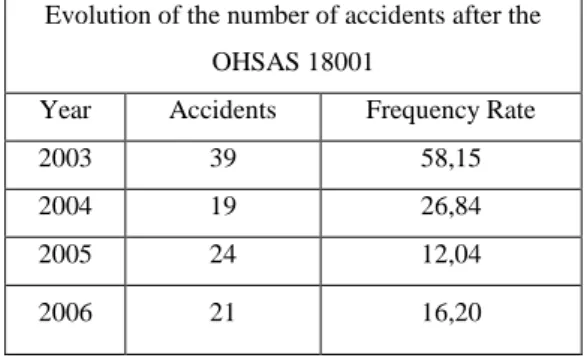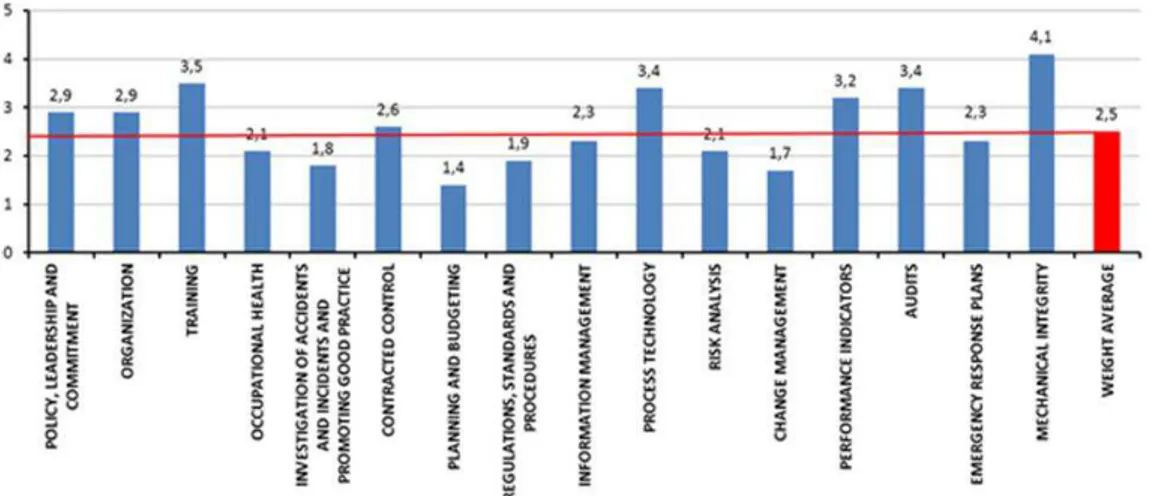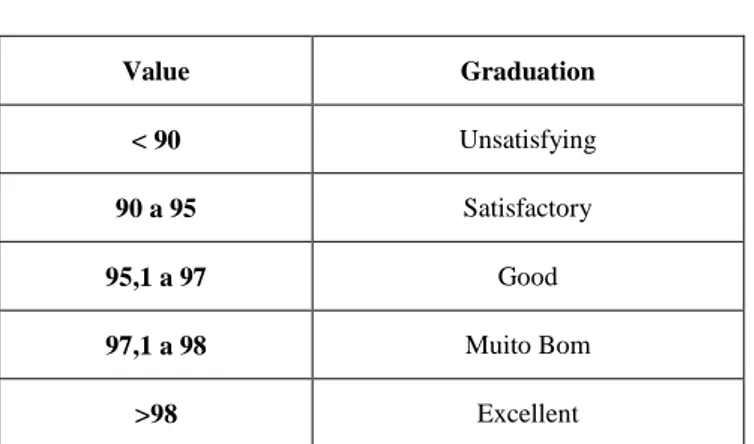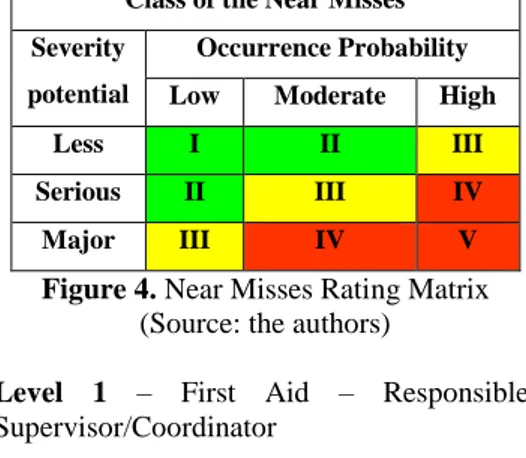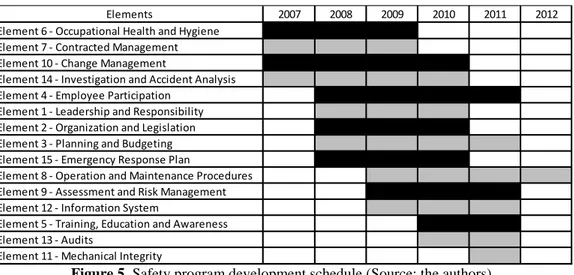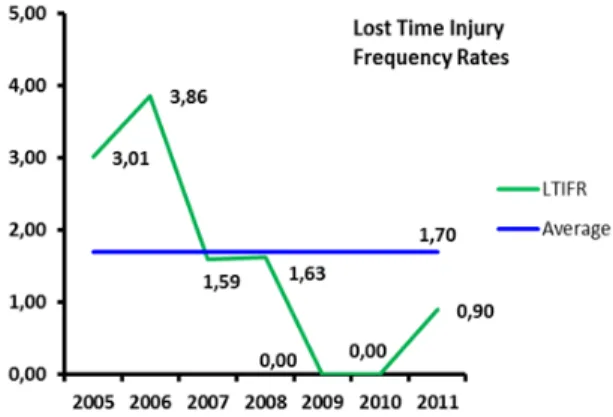International Journal for Quality Research 9(1) 123–140 ISSN 1800-6450
Edison Cesar de Faria
Nogueira
1Osvaldo Luiz
Gonçalves Quelhas
Sérgio L. B. França
Marcelo Jasmim
Meiriño
Luiz Alexandre Mosca
Cunha
Article info: Received 24.09.2014 Accepted 12.01.2015 UDC – 658.56
IMPLEMENTATION OF A SAFETY
PROGRAM FOR THE
WORK ACCIDENTS’
CONTROL. A CASE STUDY IN THE
CHEMICAL INDUSTRY
Abstract: This article presents a case study related to the implementation of a Work Safety Program in a chemical industry, based on the Process Safety Program, PSP, of a huge energy company.
The research was applied, exploratory, qualitative and with and data collection method through documentary and bibliographical research.
There will be presented the main practices adopted in order to make the Safety Program a reality inside a chemical industry, its results and contributions for its better development.
This paper proposes the implementation of a Safety Program must be preceded by a diagnosis of occupational safety and health management system and with constant critical analysis in order to make the necessary adjustments.
Keywords: Work Safety Management, Work Accident and Accidents’ Prevention
1.
Introduction
1The chemical and petrochemical industry is one of the most important sectors of the
Brazilian economy and it’s among the top
ten in the world. (Panassol, 2013, p.1). Is present in virtually all consumer goods and in all economic activities, offering solutions and contributing for the increase of the processes and the quality of the products.
It has an important participation in the Gross Domestic Product (GNP), around 3,1%. It employs 394 thousand people, mainly in the final segment (around 70% of the total), with a lower number of employees in the group of chemical products for industrial use. (Bastos and Costa, 2010, p.147).
1
Corresponding author: Edison Cesar de Faria Nogueira email: edison.nogueira@ifrj.edu.br
1.1. Initial Considerations: The chemical
industry and the work accidents’
prevention
From 1980, the pressure to regulate the Canadian chemical industry were increasing,
coated by spills, processes’ Safety and
transports incidents in Canada and abroad. Between 1985 and 1988, the members of Chemistry Industry Association of Canada developed the first Responsible Care ® Codes – including strict guidelines for the safe management and environmentally healthy of the chemical products. These codes have remained essentially unchanged for more than two decades.
In Brazil, the Chemical Industry Brazilian
Association, “ABIQUIM”, officially adopted
chemical sector and the tightening of Brazilian and international law in the
environmental, health and safety’s areas,
associated to the great accidents and contamination processes occurred in the 70
and 80’s. (Soares and Demajorovic, 2006, p. 1).
In consequence of the accidents occurred in
the 60 and 70’s and at the beginning of the 80’s, the Occupational Safety and Health
Administration (OSHA), published the 29 CFR 1910-119, thereafter, it has become mandatory, in the USA, the implementation of the PSM – Process Safety Management. The PSM is a safety system based on 14 elements that aim to reduce the accident
risks in the industries, which operate with chemical and inflammable substances.
Besides OSHA and the Chemistry Industry Association of Canada, other organizations also proposed elements to prevent accidents, as presented in Chart 1. In this chart, the elements of Occupational Accidents Prevention Program are presented, according to the API – American Petroleum Institute; ABS – American Bureau of Shipping; DNV
– Det Norske Veritas; OSHA – Occupational Safety and Health Administration; EPA – Environmental Protection Agency e OGP – International Association Oil & Gas Producer.
Table 1. Elements of accident prevention programs Bobsin (2005, p.72)
Elements API ABS DNV OSHA EPA OGP
Leadership responsibility x x
Management system x x
Legal compliance management x x x x
Operation, inspection and maintenance x x x
Organization x
Investigation and analysis of losses and loss potential
x x x x x x
Training and performance x x x x x x
Operating procedures x x x x x x
Effective communication in safety management systems (SMS)
x x
Contractors x x x x x
Mechanical integrity x x x x
Pre-startup safety review x x x x x
Change management x x x x x x
Change technology x x
Process safety information x x x x x
Emergency planning and response x x x x x x
Process hazard analysis x x x x x
Hot work permit x x x x x
Employee participation x x x
Confidential business x
Contributing to spread the implementation of voluntary management systems in WHS,
ensuring the safety, occupational health and sustainability, as a basic requirement to release the financial resources, is being fundamental for the evolution of these values inside the organizations, mainly in the developing countries, where there is a lack of a proactive legislation and an effective and responsible government oversight.
However, this symbol of success was not reflected in the drop of the number of accidents, since, according Campos and Medeiros (2009, p. 71), the organizations are searching for the implementation of their management system in health and safety at work to meet the clients demands and the legislation, forgetting the primordial, which
is control their accidents’ risks and
occupational diseases, in order to improve their performance in Work Health and Safety (WHS).
Zeng et al. (2007, p.1761) reports that Occupational Health and Safety Assessment Series (OHSAS) 18001, does not establish specific criteria of performance in WHS, neither gives detailed specification for the project of a management system. Therefore, the organizations that wish to have OSHAS 18001-2007 certify, must, first, establish a WHS Policy and implement a Safety Management System that meets the requirements of this Standard.
1.2. Problem situation
The formulation of a problem, according to Pradonov and Freitas (2013), is attached to the proposed topic: it clarifies the specific difficulties we faced and want to solve through research.
Therefore, the occupational accidents and their consequences, over the years, objects of systematic investigations, since, besides the social problems generated, they also respond for the lack of competitiveness in the industries.
So the problem situation is: The labor accident is a problem for the competitiveness of the organizations, bringing financial and
social damage, so what would be the main guidelines for a labor accidents prevention program in the chemical industry?
1.3. Purpose of the research
The purpose of the research is to analyze the practices of the occupational health and safety implemented in a chemical industry, through the revision of literature, checking if they were consistent for controlling the number of accidents.
1.4. Study delimitation
The research was delimited in relation to its extension, being restricted to a chemical industry, placed in an industrial area in Rio de Janeiro city, and the field research carried out between April, 2006 and Dec, 2011.
2.
Literature revision
For theoretical foundation of the research, surveys were used in articles of various authors from different countries and cultures, which has fundamentally related the compliance with the legislation, management system implementation in health and safety, organizational climate and culture with a decrease in the number of accidents or with
forming the safety culture.
2.1. Safety culture
People do realize, whenever there is a safe working environment, they will return, by allocating effort to Safety activities. This support the arguments that have been done by many in this field, what is, the organizations that try to improve the safety, must focus in the change of the working environment in order to motivate people to actively participate in Safety activities, instead of just blame and punish individuals who do not comply with standard working procedures (Neal and Griffin, 2006, p.952).
authors consider each organization has its own culture, which could be described as strong or weak, positive or negative. To others, just an organization with a major commitment with safety may be said as having a safety culture.
According to Araújo et al. (2006, p.9) the companies essentially turned to the legal service must adopt a new posture, considering the development in work health and safety as one of the fundamental components for their global development, and therefore, a member of its strategy.
This performance in health and safety is associated to the implementation of safety management systems, what, according to Muñiz et al. (2009, p.981) are mechanisms integrated in organizations, conceived to control the risks that may affect the health and safety of the workers, and at the same time, to ensure the company is able to easily comply with the proper legislation.
Araújo et al. (2006, p.9) say the idea of establishing a safety culture may look simple, but it will be difficult if they are not completely committed with the Safety. The demand for a cultural change and breaking a number of paradigms makes this theme complex.
Cooper (2000, p.120) defined safety culture as the reciprocal interactions of three elements:
Safety environment (Attitudes and personal perceptions);
Safety Behaviors (Behavior patterns);
Safety Management System. According to Filho et al. (2011, p.207) the interactions among these aspects may vary in intensity and in time, depending on the situation. For example, it may take time for the changes in the System of Work Safety Management (SWSM) to influence in the
behave and attitudes of the organization’s
members.
According to Klein and Dharmavaram (2012, p.261-262), the focus in organization
and culture issues must be increasingly important; if we want to achieve significant improves in the PSM. Each company, of course, has to evaluate its own operations and performance, in order to identify specific issues that are important for them.
2.2. OHSAS 18.001
OHSAS is a specification of the Occupational Health and Safety Assessment Series, which provides the requirements for a Management System of Occupational Health and Safety (MSOHS), allowing the organization to control its risks of accidents and occupational diseases and improve its performance.
According to Jørgensen et al. (2006, p.715) the OHSAS 18001 was formulated by international certification bodies, based on the BS 8800 and it was published for the first time in 1999. The OHSAS 18001 may be described as a fact pattern and it is used as a base for the certifications of occupational health and safety management systems.
Vinodkumar and Bhasi (2011, p.498) studied the influence of the certification of the management system in relation to the safety management and the development of safety in the risk of accidents on major chemical industries. The study emphasizes the necessity of OHSAS 18001’s certification in order to reduce the accidents and consequently, reduce the responsibilities and improve the productivity and the safety and health of workers.
2.3. Accidents at work
2.3.1. Legal vision
The law 8.213 from July, 24th, 1991, on its article 19, defines accident at work as:
“Accident at work is the one that occurs by
lost or permanent or temporary reduction of the capacity to work.”
This same article imputes the companies their responsibilities to prevent accidents:
“§ 1º The company is responsible to
adopt and use collective and individual measures of protection and safety of the
worker’s health.
§ 2º It is a misdemeanor, punishable by a fine, the company fails to meet the safety and hygiene work standards.
§ 3º It is the company’s duty to provide
detailed information on the risks of the operation to be performed and the product to handle.
2.3.2. Legal vision
The NBR 14.280, Cadaster of Work Accident – Procedure and Classification
defines work accident as:” Unforeseen and undesirable occurrence, instant or not, related to the exercise of the work, which
results or may result in injury.”
The OHSAS 18.001 used the term incident,
which includes the accidents and the “near misses”. For OSHAS, incident is an event
related to work, where an injury or disease (regardless of severity) or a fatality occurred or may have occurred. Accident is an incident that resulted in injury, disease or fatality, and incident, where does not happen an injury, disease or fatality may also be
nominated as an “near misses”, “almost lost”, “abnormal occurrence” or “dangerous
occurrence ".
2.4. Performance indicators in
occupational health and safety (OHS)
According to OSHAS 18001-2007, the organizations must establish, implement and keep procedures to regularly monitor and
measure the OHS’s performance. Among
others, these procedures should contain proactive standards of performance, which are able to monitor the conformity with the
OHS’s management programs and with the
operational criteria and controls and reactive standards of performance, which monitor occupational diseases, incidents (including accidents and near misses) and other historical evidences of deficiencies in the
OHS’s performance.
The International Labour Organization (ILO), in its publication GUIDELINES ON SAFETY MANAGEMENT SYSTEMS AND HEALTH AT WORK, says the selection of performance indicators must be done according to the size and the nature of
the organization’s activity and the OHS’s
objectives. Still in this publication, the monitoring and performance measurement should include either active and reactive monitoring and do not support itself only in
injuries’ statistics, health degradation, diseases and incidents related to work According to Muniz et al. (2007, p.52), the literature has focused more in measure attitudes and perceptions of the employees over the importance assigned by their organization for Safety. There are studies that emphasized the importance of the safety management systems and describe how to implement them, but there are just little work providing a specific tool to measure the implementation degree of the policies and practices that compose this management system in the organizations.
Still according Chang and Liang (2009,
p.399), many certified companies didn’t
know how to manage effectively their OHS system. One of the reasons was the
management didn’t know how evaluate the OHS’s performance. The frequency rate or the severity rate, which measures work accidents or deaths, wide used by government agencies, reflects only the work
safety’s state, but none of them is able to
2.5. Management system
For Muniz et al. (2007, p.54), a safety management system may be defined as a set of people, resources, policies and procedures that interact in an organized way, to reduce damages and losses generated in the process and in the workplace. For this system to be effective, a sustainable reduction of accident rate, must be integrated in the daily work of the organization and encourage a safe behavior of workers and their participation, for what is indispensable that the top part of management is strongly committed with them.
A management system is a set of inter related elements used to establish, and reach policies and objectives of various orders, from planning, responsibilities, practices,
procedures, processes and resources’
activities.
Still according Muniz et al. (2007, p. 54), based in previous papers about safety management and the guidelines developed by international organisms and empiric studies about safety and enviroment climate, the authors consider that the safety management system is a multi dimensional concept, composed by the following dimensions: (1) a safety policy that reflectsprinciples and values of the organization in this area; (2) the promotion
of employee’s participation in sefety activities, through direct incentives or consulting with them on issues related to their well-being at work; (3) employee training, so they will be able to perform their job in the healthiest and safest way possible; (4) the communication and transference of information about the risks the employees are exposed, as well as the correct way to fight them; (5) the planning of actions to be performed, in order to avoid accidents and be able to react quickly in an emergency, distinguishing two sub-dimensions: preventive planning and emergency planning, and, finally (6) the control or feedback over the actions taken in the organization, through the analysis of the
work and event conditions that may occur inside the organization, and comparing the company with other copanies, distinguishing two sub-dimensions: benchmarking techniques of internal control.
3.
Research results
3.1. Industry in study
The industry in study is located in the city of Rio de Janeiro, in the Industrial District of Santa Cruz and it is a joint venture between a big national energy company and a North American chemical industry, who owns the technology of catalyst for the catalytic production of oil.
Being in operation for the last 26 years, it produces catalyst for cracking oil and additives to the oil industry, being the only one in the Latin America with this kind of activity.
Its participation in the South American market is of 65%. In Brazil, is responsible for supplying the catalyst for 100% of
Petrobras’ refineries.
3.2. Safety program
The industry in study, was certified at OHSAS 18001 in 2002, but this certification
didn’t generate, as consequence, the reduction in the accidents number in its workforce (own employees more outsourced employees), as shown in table 2.
Table 2. Evolution of the number of
accidents after the OHSAS 18001
Evolution of the number of accidents after the OHSAS 18001
Year Accidents Frequency Rate
2003 39 58,15
2004 19 26,84
2005 24 12,04
3.2.1. Diagnosis
Within the objective of reducing/controlling the number of accidents, it was hired a specialized consultancy to carry out an assessment of the safety management system. To do so, the consultancy used the topics from the Program Safety Process (PSP) of the parent company of the industry in study, which had 16 queries and 202 items.
One hundred people components of the workforce, in addition to leaders, were interviewed and it was checked the evidences concerning the data provided by respondents during the survey.
The result obtained in this diagnosis for each element, was presented to the Board of Directors in February 2006 and it is shown in the figure 1.
Figure 1. Graphic of the diagnosis results performed in the industry in study in 2005 (Source:
PSP 2005 Evaluation Report)
With the level of maturity in Occupational Safety and Health between 2 and 3, and an increase in the number of accidents, the industry needed to improve itself in order to reach excellence levels and thus, keep its accidents number under control.
This way, in April 2006, as a first step, the Work Safety area was reorganized, and it was created the Safety and Environmental Coordination, reporting straight to the Board of Directors.
Some measures were taken immediately to control the number of accidents, which in April of the very year, would reach the mark of 10 accidents with injuries with no absence and 2 with injuries with absence what, if it was kept, would reach approximately 30 with injuries with no absence and 6 with
injuries with absence.
For determination of Senior Management, in order to control these occurrences, the following steps were taken:
1) Consolidation of the Quality, Safety, Environment and Health,
QHSE’s meetings with the Senior
and Middle Management’s
participation, being the meeting coordinator, the Managing Director; 2) Computerization of behavioral auditing system, for better monitoring of management goals and fast solution of assessed risks; 3) Train all managers in research and
4) Revision of the standard investigation and accident analysis 5) Establish a Safety Program in order
to create a management system, initially Safety and Health at Work, to obtain consistent results;
3.2.2. QSMS Meetings
The QSMS Meetings, from 2006, were monthly, with the participation of the Board of Directors, Managers, Work Safety, ICPA and guests.
At this meeting the following topics were discussed:
3.2.2.1. Non Conformity report statistics
(NCR’s)
In 2006 it was presented to the industry, in a general way, and it was modified in 2007, to be presented by management, in order to identify the ones with problems to meet the deadlines.
3.2.2.2. Health indicators
The main health indicators presented were:
Clinical pathologies; comply with outsourced companies; number of exams carried out (Admission, periodic, return to work and dismissal); Main abnormality vectors in complementary medical examinations (Glucose, triglycerides etc.); Result of Hearing Conservation Program
3.2.2.3. Work safety indicators
Initially in 2006, only the Frequency and Severity Rates were presented in the meetings. From 2007 on, it was included the hours of behavioral audits carried out by each management, comparing them with the established target. From 2009 on, it was included the deviations by non-utilization of Personal Protective Equipment (PPE), by
observation of safe behavior, occupational hygiene and Evolution of the Safety Program.
3.2.2.4 CIPA (Internal Commission for Accident Prevetion)
In all meetings, the President, the Vice President or a member if CIPA, was present
to present a summary of the CIPA’s activities, in the meeting’s reference month.
3.2.3. Computerization of behavioral audit system
In 2006, the Board of Directors, at its Brazilian parent, was able to release a new software named AUDICOMP.
To adequate it for the implementation of a management system facing the line responsibility and also, for the accidents control, the binomial environment and human behavior must be observed together.
3.2.3.1. Line responsibility
The result of all audit was necessarily directed to the knowledge of the management responsible for the area where the danger or the aspect was identified or where it was observed an inadequate behavior, for the solution of the problem.
3.2.3.2. Safe behavior index
In the case of behavioral observation, in the
filling of the “AUDICOMP”, the auditor had
to insert in the proper place, the number of the observed people, the number of people committing deviation and the expected effect.
Based on these variables, the system calculated the Safety Behavior Index, which was immediately informed to the area Manager.
Value Graduation
< 90 Unsatisfying
90 a 95 Satisfactory
95,1 a 97 Good
97,1 a 98 Muito Bom
>98 Excellent
Figure 2. Evaluation of the Observed Behavior –SBISource: the authors - 2013
3.2.3.3. Risk rate (RR)
The risk rate was calculated based on the
Potential Severity and Probability of Occurrence (Figure 3).
Value Assessment
1 a 3 Tolerable
9 a 10 Moderate
30 a 100 Substantial
Figure 3. Evaluation of the Risk Rate
Source: the authors - 2013The RR’ s result and the risk evaluation were directly informed to the Manager, through the electronic mail, just after the audit be inserted in the system.
3.2.4. Accident investigation training
The entire leadership was trained in analysis and investigation of accidents by the same consultant who provided service to its parent company in its corporate university, with a work time of 24 hours. The technique used was the Causes Tree.
3.2.5. Review of accident investigation Standard
The standard was revised, and five levels of accidents were created: Incidents or Near
Misses: Responsible:
Supervisor/Coordinator.
The near misses were evaluated and classified according to the probability of occurrence and the severity potential. In case its classification was IV or V in Near Misses
Rating Matrix, figure 4, the investigation system would be stricter, treating this event as a Level 2.
The classification of the severity potential was done from the following criteria:
Major (MA): If the incident’s
causes were not blocked, there will be risk of accident with death, disabling injury, occupational diseases and other severe injuries, such as: fractures, amputations, burns, bleeding, shock, asphyxiation, loss of vision or hearing and poisoning;
Serious (SE): If the incident’s
causes were not blocked, there will be the risk of accidents with personal injury causing loss of time for temporary disability (absence);
Class of the Near Misses
Severity
potential
Occurrence Probability
Low Moderate High
Less I II III
Serious II III IV
Major III IV V
Figure 4. Near Misses Rating Matrix
(Source: the authors)
Level 1 – First Aid – Responsible: Supervisor/Coordinator
The analysis and investigation of the occurrence is done just between the Supervisor/Coordinator and the injured subordinate.
Level 2 – Accident with injury with no absence – Responsible: Hierarchic Coordinator of the injured person or from the area whenever occurs an environmental incident or accident.
The analysis and investigation of the accident is done by a multi-disciplinary group with the mandatory presence of the Work Safety technician and a member if APIW.
Level 3 – Accident with injury with absence
– Responsible: Hierarchic Manager of the injured person or from the area whenever occurs an environmental incident or accident.
The analysis and investigation of the accident is done by a multi-disciplinary group with the mandatory presence of the Hierarchic Coordinator of the injured person, the Coordinator of Safety and Environment, Technical Consultant of Environment (for environmental accidents), Work Safety Technician, Environment Technician (for environmental accidents), and a member of CIPA for personal accidents.
Level 4 – Accidents with total permanent disabling injury or environmental accident – Responsible Managing Director.
The analysis and investigation of the accident is done by a multi-disciplinary
group with the mandatory presence of the Hierarchic Coordinator and Manager of the injured person or from the area where the environmental accident happened, the Coordinator of Safety and Environment, Technical Consultant of Environment (for environmental accidents), Work Safety Technician, Environment Technician (for environmental accidents), and a member of CIPA for personal accidents.
For accidents level 3 and 4, it was established a time of 7 working days for analysis, investigation of causes and preparation of an action plan, counting from the day immediately after the accident.
3.2.6. Structure and detailing
The Safety Program was elaborated based on the 15 guidelines of the PSP from one of the controlling companies in the industry study.
After eight months of elaboration, with the participation of the entire management, in December 2006, it was approved by the CEO, the Safety Program based on the following principles:
Visible commitment – All the
leadership levels must demonstrate the SMS is a VALUE, through their attitudes, decisions and words.
Line responsibility – All the
leadership levels are responsible for the SMS issues in their area.
Deviation of administration -
Every loss is ALWAYS preceded by one or more DEVIATIONS. The identification of the significance of deviations in a preventive way will allow the lock of loss.
Continuous learning – People and the organization’s continuous
learning is vital to achieve the
SMS’s excellence
Its structure was composed by sixteen elements:
Element 1 – Leadership and Responsibility
Legislation
Element 3 - Planning and Budgeting
Element 4 – Employee Participation
Element 5 – Training, Education and Awareness
Element 6 – Occupational Health and Hygiene
Element 7 – Contracted Management
Element 8 – Operation and Maintenance Procedures
Element 9 – Assessment and Risk Management
Element 10 – Change Management
Element 11 – Mechanical integrity
Element 12 – Information System
Element 13 – Audits
Element 14 – Research and Accident Analysis
Element 15 – Emergency Response Plan
3.2.7. Program development
The Board of Directors and senior management defined the following development schedule of the Safety, Health and Environment Program, SHEP:
2007 2008 2009 2010 2011 2012
Element 6 - Occupational Health and Hygiene Element 7 - Contracted Management
Element 10 - Change Management 2 3 4 5
Element 14 - Investigation and Accident Analysis
Element 4 - Employee Participation 2 3 4 5
Element 1 - Leadership and Responsibility Element 2 - Organization and Legislation Element 3 - Planning and Budgeting Element 15 - Emergency Response Plan
Element 8 - Operation and Maintenance Procedures Element 9 - Assessment and Risk Management Element 12 - Information System
Element 5 - Training, Education and Awareness Element 13 - Audits
Element 11 - Mechanical Integrity Elements
Figure 5. Safety program development schedule (Source: the authors)
3.2.7.1. Leadership and responsibility
The commitment of the leaderships in Safety, Environment and Health (SHE), were very well defined in the behavioral audits, in the work accident procedure, in the participation in meetings Quality, Safety, Environment and Health (QSEH), in the participation in corporate training, in understanding the importance of motivating the employees in the legal requirements training and mainly in relation to presidency of ICPA, Internal Committee to Prevent Accidents, where there was a turnover between the second line of each of the hierarchical management in the presidency.
3.2.7.2.
Organization and legislation
The industry kept a contract with a consultant company, which monthly updated all the legislation inherent to its activities.It was made available the access for all hierarchic levels of the basic, Federal, State and Municipal legislation, related to Safety, Environment and Health (SHE).
legal requirements regarding Safety, Environment and Health of their area.
3.2.7.3. Planning and budgeting
Up to 2008, the investments for SHE didn’t have the criteria defined for its prioritization which caused distortions and resource allocation concerning the portfolio of "end of
life" in the portfolio of "SHE”. From the
introduction of the criteria based on the demand of legal requirements, in greater control of the dangers and aspects and causes of accidents, near-misses and deviations, the investments should be justified and framed in this criteria to be included in the SHE portfolio. For this portfolio, 40% of the industry annual investments were destined, something around R$ 4millions.
The total investment in the SEH’s area, was
approximately R$ 19.950.000, 00, from 2007
to 2011, representing 27% of the industry’s
total investments.
3.2.7.4. Employee participation
T
he employee’s participation was done through the CIPA and daily, talking to the team of the Safety and Environment Coordination (SEC) or even through their hierarchical superiors who took theirexpectations to the QSEH’s meetings.
Monthly, in the management board to be seeing by the SHE, it was posted the results concerning to Frequency rates With Injury With Absence and No Absence, Severity Rate, Effluent in Specification, Nursing Care, Number of Performed Medical Exams and Educational information about the SHE.
3.2.7.4. Employee participation
The employee’s participation was done
through the CIPA and daily, talking to the team of the Safety and Environment Coordination (SEC) or even through their hierarchical superiors who took their
expectations to the QSEH’s meetings.
Monthly, in the management board to be seeing by the SHE, it was posted the results concerning to Frequency rates With Injury With Absence and No Absence, Severity Rate, Effluent in Specification, Nursing Care, Number of Performed Medical Exams and Educational information about the SHE.
3.2.7.5. Training, education and awareness
The industry has always invested in training its own workforce, either in MBA, Graduate Studies and English courses. The on the job and certification trainings and training process operators show the concern of the industry in study on continuous improvement of its work force.
Some training were controlled directly the Safety and Environment Coordination , as the Change Management, Analysis and Investigations of Accidents, Risk Map Interpretation, Confined Space, Hearing Conservation Program and Respiratory Protection Program. This control was done through a database in Excel.
In 2009, 19.310 hours of training were carried out, while in 2010, there were 12.850 and 2011, 18.867 hours.
3.2.7.6. Occupational health and hygiene
Over the years, the industry hired consultants to elaborate to elaborate its Occupational Risk Prevention Program (ORPP), with the only objective of meeting a legal determination.
In 2007, the Safety and Environment Coordination, justified at the Board of Directors, that either financially as for the safety of the employees, the whole work of Occupational Hygiene should be done by the team and with their own equipment.
3.2.7.7. Contracted management
All third parties were required to undergo a Safety setting and to prove through a test, they were literate. The minimum grade to be approved and be authorized to work inside the industry was 5.
All requesters that required specific courses
according to the RS’s 10, 11 and 33, besides completing the training for requesting PT, they were required to present the certificate in the referred course and after checked by the Technicians of the SEC, it was posted in the back of the name tag, a label with the authorization for specific jobs (electricity, confined space and equipment operation).
The control over the ORPP and the Medical Control and Occupational Health Program (MCOHP) of the third parties, was done through an Excel spreadsheet, which indicated when they were about to expire and the contract manager was immediately informed in order to request to the third party, the review of documents.
All the ORPP’s were analyzed and checked
to see if they were in compliance or not with the legislation. In a negative case, the contract manager was informed in order to also inform the third party to present a new document.
3.2.7.8. Standards / Operating procedures and maintenance
All maintenance work was preceded by an analysis to verify the need to prepare the Preliminary Risk Analysis (PRA), level 1 or level 2. This necessity was concretized as the task to be performed was not standardized. The PRA level 2was just necessary if there was in the PRA level 1, at least one positive answer.
3.2.7.9. Assessment and risk management
The OSHAS 18.001-2007’s certification, has made the industry maintained updated the spreadsheets of hazard / risk and aspect /
impacts.
After the implementation of the Change Management, any change occurred in the company was assessed to verify the insertion of new risks in the process or in the administrative area. This assessment could be done through techniques as the Preliminary Risk Analysis, What-If and Hazop.
For maintenance activities that had no procedure, it was mandatory the elaboration of a PRA, level 1, which could derive a PRA level 1, more complex and which required the participation of Occupational Safety or Environment team.
Besides, to work in dangerous lines, ie, pipes containing products classified as dangerous, it was required to be issued a work permit.
3.2.7.10. Change management
In 2007, it was approved by the Senior Management, the standard of Change Management, deploying in the industry, this tool to prevent accidents.
It forecasted two checklists, one relative to the changes in the operational area and the other, the administrative one.
These lists are composed of a part A, where there were the significant items and a part B, where there were the moderate items. The marking of any item in the part A indicated that the proposal was a change and that a multidisciplinary team need to perform a risk analysis.
All the checklists, after filled, are signed by the requester, by his/her hierarchic Superior and by the area manager.
3.2.7.11. Mechanical integrity
The concern about the reliability of their systems is a constant for a safe operation.
3.2.7.12. Information system
The industry has always been guided by a transparent and effective communication. The called Bulletin Board – Internal Communication, was the strongest way of communication, so much that was done in hard and electronic media and it was filled in a folder of public domain.
Together with the SHEP, it was done the
“Management in Sight of the SHEP”, which
had as a target to disclose the performance indicators in Safety, Health and Environment and also awareness / educational information about these 3 areas.
The Bulletin Board had a weekly basis while the Management in Sight of the SHEP, was monthly.
3.2.7.13. Audits
In addition to internal audits conducted annually between February and March, in preparation for the maintenance audits or certification standards in ISO 9001, 14001 and OSHAS 18001, the behavioral audits were consolidated, which involved either the human behavior, as the aspect of the work enviroment. In 2010, it began to be put into practice, audits of knowledge and change management to verify the need of a new
training by the work force in the SEH’s
issues and the compliance with the standard of the management Changes, by the various industry managements.
There were also performed audits of Legal Requirements, from November to January and the ones specific of RS 10 and RS 13.
3.2.7.13. Research and accident analysis
The training in the Research and Accident
Analysis, became a routine for the CIPA’s
training as well as for the and updating of managers, that is, every year it happened.
The standard revised in 2006, has suffered just few changes and none of them significant.
A database was created for near misses and accidents, with access for all the employees.
3.2.7.14. Emergency response plan
The Emergency Response Plan passed through many revisions, the latter being the inclusion of emergency scenarios industry. The shift of the emergency team has undergone a makeover and it was also considered the health issues of the members, and it was mandatory that all of them were able to participate in this team. The field training was half-yearly and monthly meeting was held in order to keep the team in activity.
3.3. Final thoughts
The main demand for the deployment of the Safety Program in the industry, was the accidents control, so the set of action developed over the five years for the accidents control, presented favorable results that can only be evaluated with more consistency with the maintenance of the adopted measures and the inclusion of others, which add the effort to keep the number of accidents under the reasonable for an industry that wishes to achieve the excellence in Occupational Safety and Health.
For the successful implementation of a
Safety Program, the employee’s involvement
was fundamental. In the industry under study, the visible commitment and responsibility for the SEH’s issues by all levels of leadership, was fundamental for the
credibility of the Program’s implementation
with employees.
4.
Results discussion
Based on the Frequency Rate, a reactive
indicator, however, directly related to the accident numbers, we verified that just after
the beginning of the Program’s
implementation, there was a sharp drop in this indicator, again displaying a slight rise in 2008, and remaining stable from this year on.
The graphics in the figures 6 and 7 show that all the rates, even with fluctuations, were kept under control, do not trespassing the average of the last seven years after the Safety Program implementation
Figure 6. Average (2005-2011) WLTIFR x Evolution TFSA (Source: the authors – 2013)
Figure 7. Average (2005-2011) LTIFR x Evolution TFCA (Source:the authors)
5.
Conclusion recommendation for
further researches
This research aimed to present the basic
guidelines to implement a Safety Program with the target of controlling the accidents in a chemical industry.
which everybody is involved.
Although the industry under study was already certified in OHSAS 18001, it did not have a structured management system in what it was clear the interconnection of all activities performed on behalf of Work Safety. Thus, the structure for the Safety Program implementation was carried out with this purpose, with the participation of all of them in each one of the elements and disseminating the best existent safety practices in the world.
With the effective participation of the middle and upper managers in the process, the safety climate has increased, becoming clear for the people, the commitment of the industry with the Work Safety.
The behavioral audits had a key role in order to change the behavior of people within the industry. With fixed monthly hours targets,
practically every day, each hour, there was an auditor performing a behavioral audit.
Thus, analyzing the graphs of frequency rate over the years of the Program implementation, one may conclude it was efficient to control the accidents.
So, the research achieved the proposed result, presenting the basic guidelines for the implementation of a Safety Program for the accidents control.
As a recommendation for the next research, the increasing number of industries to be researched in order to consolidate the essential elements for the implementation of a Safety Program, as well as establish a method to measure the implementation in order to present through graphics if the deployment pace is reaching or not the set target, correlating this pace with the work accidents curve.
References
:
Araújo, G.M. (2005). Evaluating Maturity of a Management System: A proposal for an instrument. Dissertation (Master in Management System). Universidade Federal Fluminense, Niterói.
Araújo, R.P., Santos, N.; Mafra, W.J. (2007), Management of Safety and Health at Work. In: EXCELLENCE SYMPOSIUM ON MANAGEMENT AND TECHNOLOGY, IV, 2007, Resende, Rio de Janeiro.
Bastos, V.D., & Costa, L.M. (2010). Trade and investment potential in the Brazilian chemical industry:2010-2013 In:, INVESTMENT OUTLOOK: 2010-2013. 2010, Rio de Janeiro, Livro, Rio de Janeiro, BNDES, p. 145-199.
Bobsin, M.A. (2005). Safety Management, Environment and Health: Motion System Design and Performance Evaluation Methodology. Dissertation (Professional Master in Management Systems), 2005. Universidade Federal Fluminense, Niterói.
Campos, C.A.O., & Medeiros, D.D. (2009). A management system integration model. Production, 19(1), 070-086.
Chang, J., & Liang, C. (2009). Performance evaluation of process safety management systems of paint manufacturing facilities. Journal Of Loss Prevention In The Process Industries, 22(4), 398-402. doi:10.1016/j.jlp.2009.02.004
Cooper Ph.D., M. (2000). Towards a model of safety culture. Safety Science, 36(2), 111-136. doi:10.1016/s0925-7535(00)00035-7
Fernández-Muñiz, B., Montes-Peón, J., & Vázquez-Ordás, C. (2007). Safety management system: Development and validation of a multidimensional scale. Journal Of Loss Prevention In The Process Industries, 20(1), 52-68. doi:10.1016/j.jlp.2006.10.002
occupational safety management and firm performance. Safety Science, 47(7), 980-991. doi:10.1016/j.ssci.2008.10.022
Filho, A.P.G., Andrade, J.C.S., & Marinho, M.M. de O. (2011). Culture and Safety Management at Work: a proposed model. Production Management, São Carlos, 18(1), 205-220.
Jørgensen, T., Remmen, A., & Mellado, M. (2006). Integrated management systems – three different levels of integration. Journal Of Cleaner Production, 14(8), 713-722. doi:10.1016/j.jclepro.2005.04.005
Klein, J., & Dharmavaram, S. (2012). Improving the performance of established PSM programs. Process Safety Progress, 31(3), 261-265. doi:10.1002/prs.11494
Neal, A., & Griffin, M. (2006). A study of the lagged relationships among safety climate, safety motivation, safety behavior, and accidents at the individual and group levels. Journal Of Applied Psychology, 91(4), 946-953. doi:10.1037/0021-9010.91.4.946
Panassol, M., (2013). Chemical Industry in Brazil. Retrieved from:
http://www.pwc.com.br/pt_BR/br/publicacoes/setores-atividade/assets/quimico-petroquimico/chemicals-port-13.pdf, 11p. Technical Report.
Soares, F.R., & Demajorovic, J. (2006). The Responsible Care Program in Brazil. In: II Workshop Integrated Management: Risk and Sustainability, São Paulo: Centro Universitário Senac, 1.
Vinodkumar, M., & Bhasi, M. (2011). A study on the impact of management system certification on safety management. Safety Science, 49(3), 498-507. doi:10.1016/j.ssci.2010.11.009
Edison Cesar de Faria Nogueira
Fluminense Federal University, MSG/LATEC Rio de Janeiro Federal Institute of Education, Science and Technology, 1045 Lucio Tavares St, Nilópolis
Rio de Janeiro Brasil
edison.nogueira@ifrj.edu.br
Osvaldo Luiz Gonçalves Quelhas
Fluminense Federal University, MSG/LATEC 156 Passo da Pátria St, sala 329-A - Bloco E CEP 24210-240
Niterói Rio de Janeiro Brasil
quelhas@latec.uff.br
Sérgio L. B. França
Fluminense Federal University, MSG/LATEC 156 Passo da Pátria St, sala 329-A - CEP 24210-240, Niterói
Rio de Janeiro Brasil
sfranca@latec.uff.br
Marcelo Jasmim Meiriño
Fluminense Federal University, MSG/LATEC 156 Passo da Pátria St, sala 329-A - CEP 24210-240, Niterói
Rio de Janeiro Brasil
marcelo@latec.uff.br
Luiz Alexandre Mosca Cunha
Fundação Oswaldo Cruz - CTM
Av. Comandante Guaranys, 447 - Jacarepagua
Rio de Janeiro Brasil
